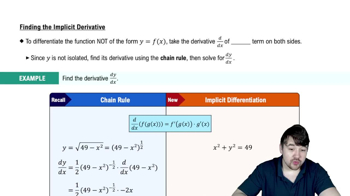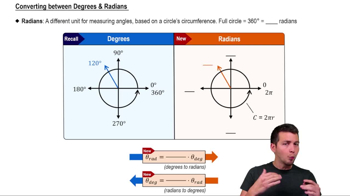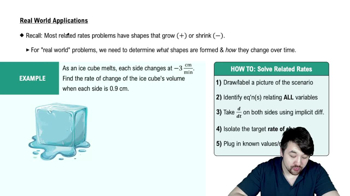Table of contents
- 0. Functions7h 52m
- Introduction to Functions16m
- Piecewise Functions10m
- Properties of Functions9m
- Common Functions1h 8m
- Transformations5m
- Combining Functions27m
- Exponent rules32m
- Exponential Functions28m
- Logarithmic Functions24m
- Properties of Logarithms34m
- Exponential & Logarithmic Equations35m
- Introduction to Trigonometric Functions38m
- Graphs of Trigonometric Functions44m
- Trigonometric Identities47m
- Inverse Trigonometric Functions48m
- 1. Limits and Continuity2h 2m
- 2. Intro to Derivatives1h 33m
- 3. Techniques of Differentiation3h 18m
- 4. Applications of Derivatives2h 38m
- 5. Graphical Applications of Derivatives6h 2m
- 6. Derivatives of Inverse, Exponential, & Logarithmic Functions2h 37m
- 7. Antiderivatives & Indefinite Integrals1h 26m
- 8. Definite Integrals4h 44m
- 9. Graphical Applications of Integrals2h 27m
- 10. Physics Applications of Integrals 2h 22m
4. Applications of Derivatives
Related Rates
Problem 3.11.26b
Textbook Question
A bug is moving along the right side of the parabola y=x² at a rate such that its distance from the origin is increasing at 1 cm/min.
b. Use the equation y=x² to find an equation relating dy/dt to dx/dt.
 Verified step by step guidance
Verified step by step guidance1
Start by understanding the problem: We have a bug moving along the parabola y = x², and its distance from the origin is increasing at a rate of 1 cm/min. We need to find a relationship between dy/dt and dx/dt.
Recall that the distance from the origin to a point (x, y) on the parabola is given by the distance formula: d = √(x² + y²). Since y = x², substitute y in the distance formula to get d = √(x² + (x²)²) = √(x² + x⁴).
Differentiate the distance formula with respect to time t to find the rate of change of distance: d(d)/dt = (1/2) * (1/√(x² + x⁴)) * (2x * dx/dt + 4x³ * dx/dt). Set this equal to 1 cm/min, as given in the problem.
Now, differentiate the equation y = x² with respect to time t to find dy/dt: dy/dt = 2x * dx/dt.
Combine the results from the differentiation of the distance formula and the parabola equation to express dy/dt in terms of dx/dt. Use the fact that d(d)/dt = 1 cm/min to solve for dy/dt in terms of dx/dt.
 Verified video answer for a similar problem:
Verified video answer for a similar problem:This video solution was recommended by our tutors as helpful for the problem above
Video duration:
5mPlay a video:
Was this helpful?
Key Concepts
Here are the essential concepts you must grasp in order to answer the question correctly.
Related Rates
Related rates involve finding the rate at which one quantity changes in relation to another. In this problem, we need to relate the rates of change of the bug's position along the parabola (dx/dt and dy/dt) to its distance from the origin. This concept is essential for setting up the equations that will allow us to solve for the desired rates.
Recommended video:

Intro To Related Rates
Implicit Differentiation
Implicit differentiation is a technique used to differentiate equations that define y implicitly in terms of x. Since the bug's position is described by the equation y = x², we can differentiate both sides with respect to time t to find a relationship between dy/dt and dx/dt. This method is crucial for relating the rates of change in this context.
Recommended video:

Finding The Implicit Derivative
Distance Formula
The distance formula calculates the distance between two points in a coordinate system. In this scenario, the distance from the origin to the bug's position on the parabola can be expressed as D = √(x² + y²). Understanding this formula is vital for determining how the distance changes over time, which is central to solving the problem.
Recommended video:
Guided course

Converting between Degrees & Radians
Related Videos
Related Practice





